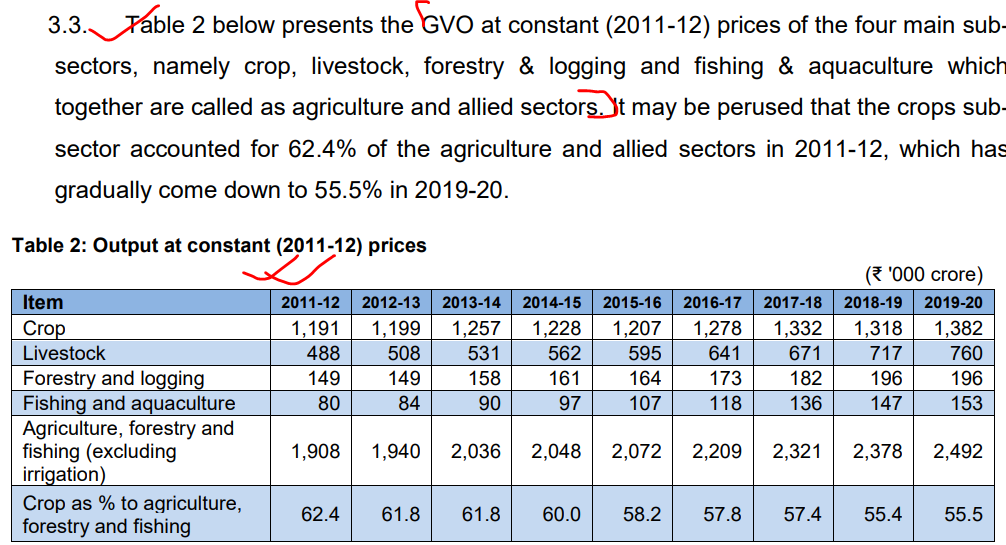Goaltide Daily Current Affairs 2022
Current Affair 1:
Government Data Roundup: Three reports.
Report name: State-wise and Item-wise Value of Output from Agriculture, Forestry and Fishing (Year: 2011-12 to 2019-20)








Envi Stats India 2022 Volume II Environment Accounts


Key Highlights:
- In India, there are currently 55.76 million hectares of wasteland, or a huge 16.96% of the country’s total land area, as of 2015–16.
- A total of 912,06,650 hectares of land were included in the land degradation account as of 2015–16. This is less than the opening stock in 2005–2006, which was 912,98,196 hectares.
- According to India’s Asset Account for Land Use and Land Cover (LULC), the amount of land that is fallow for agriculture, snow, and glaciers has increased, while the amount of deciduous and evergreen forest has decreased from 2005-2006.
- The Gini Index of Land Concentration, a gauge of fragmentation, declined slightly from 0.59 to 0.57 between 2005-06 and 2015-16.
- The average operating holding size decreased from 1.15 hectares in 2010–11 to 1.08 ha in 2015–16. By 2020–21, this is most likely to decline even more.
India Productivity Report

Key Highlights of the report:
- In terms of broad industries, the services sector increased more quickly each year (7.3%) than the others, whereas agriculture grew at a significantly slower rate each year (3.1%).
- Between 1980 and 2017, the Indian economy experienced a major transformation in the employment structure. The percentage of manufacturing employment decreased from 70% to 42% and services increased from 17% to 34%, respectively, whereas the percentage of agriculture employment decreased from 70% to 42%. Between 1981 and 2017, India’s employment increased by 1.3% a year on average.
- In India, the workforce participation rate (WFPR) dropped from 38.6% in 2011–12 to 34.7% in 2017–18, which is consistent with almost no employment growth during 2008-17.
- A positive structural change effect is suggested by the static reallocation effect, which shows that workers have moved to industries with significantly higher productivity levels. This effect accounts for 25% of the overall productivity gain between 1981 and 2017 and has been positive.
- However, a cross-country comparison shows that India’s level of labour productivity is still quite low when compared to other chosen countries, despite having one of the highest average annual growth rates of 5% between 1981 and 2017.
Current Affair 2:
What is greenwashing?
Greenwashing is a term commonly used to indicate deceptive marketing and advertising tactics to deceive stakeholders into believing that a particular product is environmentally friendly.
One of the major motives of greenwashing is to create public confusion and manipulate public opinion to sway consumer markets.
How is greenwashing harmful and what can be done about it?
One of the major motives of greenwashing is to create public confusion and manipulate public opinion to sway consumer markets. But is that likely to have a significant impact on the environment or public health?
Take for example, a 2008 advertisement from the Malaysian Palm Oil Council that claimed it was eco-friendly. The ad stated that the palm oil plantations “help our planet breathe and give homes to hundreds of species of flora and fauna.” But critics of the ad pointed out that palm oil plantations are associated with deforestation, loss of rainforest species and habitats, pollution from burning to clear land, and destruction of flood buffer zones along the rivers. Several oil plantation executives distanced themselves from the advertisement video.
Currently, strong backlashes in public opinion against greenwashing have been keeping this practice somewhat under control. Strong social accountability and a tripartite system, consisting of an organisation, a regulatory authority, and a third party (made up of stakeholders, civil society members, NGOs, etc.) have been suggested as ways to curb greenwashing. However, as of now, such structured systems to reign in greenwashing are yet to be developed in most countries.
Current Affair 3:
Foreign Direct Product Rule (FDPR)
To regulate the transfer of US technologies, the Foreign Direct Product Rule, or FDPR, was originally introduced in 1959. It effectively states that the US government has the authority to prevent the sale of any product developed with American technology, including those produced elsewhere.
How is the US using it? You will get clarity.
To prevent China's advanced computing and supercomputer business from acquiring sophisticated computing chips, US officials applied the rule to it on Friday.
In August 2020, the rule came to light when it was applied to the Chinese telecom corporation Huawei Technologies Co Ltd. American officials attempted to stop Huawei from receiving semiconductors, but they discovered that companies were still sending Huawei chips produced in facilities outside of the US.
A choke point was eventually identified by US regulators: almost all semiconductor manufacturing uses vital tools from US suppliers. So, they increased the FDPR to regulate the trading of chips produced with US tools or technology. The US regulators used that action against Russia and Belarus to cut off chips after the invasion of Ukraine, which dealt a blow to Huawei's smartphone industry.
<< Previous Next >>


